Well, here we are folks. The Christmas tree has been stripped and unceremoniously tossed to the curb. The stockings and ornaments are back in their basement home. The last of the stale cookies have been thrown to the birds. As gardeners this is a tough time of year. It’s cold. It’s gray. And the only thing on the horizon to pique a modicum of interest is Ground Hog Day!
But all is not lost. In most parts of the temperate world, there are plants that can brighten the winter landscape through even the darkest of gray days. Some are subtle in their impact. Others are bold. But all are welcome reminders of the spring that is to come.
Here are a few winter favorites from Yew Dell Botanical Gardens . . .
Hellebores
Fifteen or so years ago when we first started to collect and evaluate hellebore varieties, few were available on the market. But fortunately today they have finally become widely available . . . and for good reason.
There are a dozen or more species in the genus Helleborus, mostly from western Asia and Eastern Europe, but most sold on the market fall under a hybrid group named Helleborus x hybridus – a Heinz 57 mix of darned good genetics. They are mostly tough-as-nails, herbaceous perennials with evergreen foliage and flowers that bloom all through the winter and early spring. Happiest in a lightly shaded garden, hellebores are quite adaptable, highly resistant to deer and rabbit browse and they are, quite frankly, some of the easiest plants to grow in the garden.

But of course it is the flowers that rightfully get top billing. Standing 12”-18” tall, the freshly produced stalks arise from the plant’s central crown and are topped with cheerful blooms that can range in color from pure white to vivid rose, deep burgundy, pink and yellow. There are even green flowered forms if you like that sort of thing (I do!) There are speckled, spotted and banded forms as well as doubles.
Hellebore blooms last a long time on the plant but also make excellent cut flowers. And if there’s one thing that’s better than fresh new January blooms out in the garden, it’s a bouquet of fresh cut flowers gathered from the garden and enjoyed inside, along with a crackling fire and a hot cup of tea.
Two gardening tips for maintaining your hellebores . . .
1) If you have them in your garden, get out there now and cut back the old foliage before the new blooms emerge. It makes the work much easier and avoids the unintentional harvesting of new blooms.
2) When the flowers are finished making their show, deadhead the old blooms to keep them from going to seed. Hellebores do like to seed around a bit.
Witchhazels
For a little winter show a bit closer to eye level, members of the genus Hamamelis are hard to beat. While the North American native common witchhazel (Hamamelis virginiana) is a fall bloomer, the most popular garden forms are the winter blooming species from both North America (H. vernalis) and Asia (H. japonica and H. mollis).
Witchhazel flowers are unlike anything you’ve seen in the garden world. Rather than big, billowy petals like a magnolia or rhododendron, witchhazel flowers are made up of tiny, threadlike petals that can be up to an inch long but not much more than about 1/8th inch wide. They come in flower colors ranging from bright yellow to deep gold, orange, red and burgundy. But what they lack in size they make up for in quantity. A well grown witchhazel can create a brilliant cloud of blooms through a long stretch of the winter season. They are fragrant and make great cut stems to bring inside on a winter’s day.
One of the fun bits to watch with witchhazels is what happens after the flowers emerge. Being winter bloomers, they tend to take advantage of warm sunny days here and there. But when the weather turns again, the petals curl up and wait out the cold front. When the warmth returns, they unfurl to continue the show.

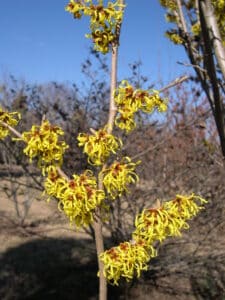
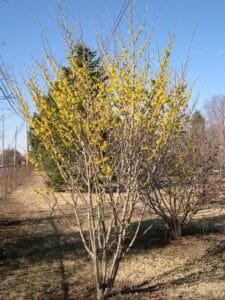

Winterberry Holly
Ok, I’m cheating here a bit. Winterberry hollies (Ilex verticillata and hybrids) aren’t known for winter flowers but rather for their winter fruit. If you drive around your neighborhood this time of year you’ll undoubtedly come upon a brilliant mass of red berries on otherwise bare stems. And depending on the variety, weather and the local bird populations, winterberry holly fruit can put on a show from the middle of fall, straight through until Easter.
Winterberry holly is a North American native shrub found in damp soils, pond edges and boggy conditions throughout much of the Midwest and Northeast but they perform just fine on any typical garden soil. They are medium-sized shrubs that are easy to grow in full sun and since they drop their leaves in fall, their berry show is even more spectacular than most of their evergreen cousins.
Of course like all hollies, fruit is produced only by female specimens and you need a male in the general vicinity to provide the necessary pollen. If installing a mass planting, about one male for about 10 females seems to be a good ratio.
Of course if these winter performers don’t do it for you, you can always just plan a Ground Hog Day party!
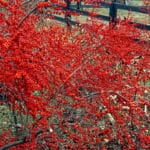
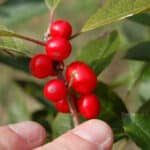

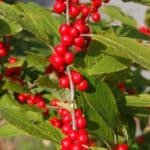
This article was originally submitted to the Courier Journal on January 5, 2022.

